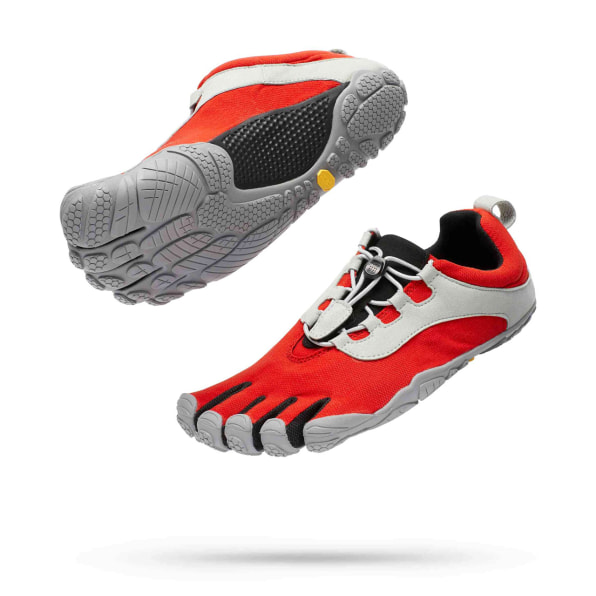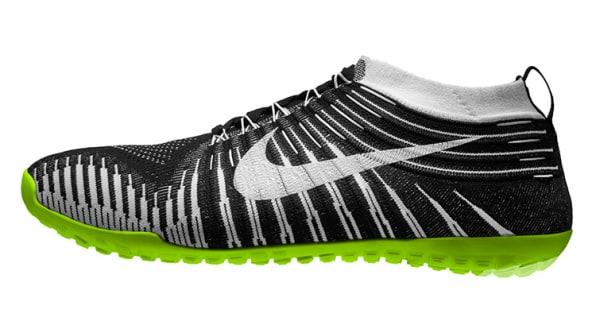Athletes and ‘ancestral living’ adherents alike suddenly have more options than ever to feel it in their soles.

There’s a war being waged under our feet.
On one side are the sneakers with hyper-cushioned, almost comically bulky soles that have unexpectedly become fashionable recently, such as the popular ones by the brand Hoka. Once considered “clown shoes,” they are now so trendy that they’re eating the lunch of industry giants. These pillowy soles not only provide luxurious support, but most models also promise to actually return energy from striking the ground back into the wearer’s foot. The energy transfer happens via a carbon or plastic plate that was at first considered so revolutionary that it was deemed cheating. Some running shoes touting these benefits were even banned from international competition.

On the other side are the minimalist, “barefoot” sneakers, meant to provide as little support as possible so that a runner can move around the world in the same way as our ancient ancestors did. (Proponents will also tell you that even in modern times, Ethiopian runner Abebe Bikila won the 1960 Olympic marathon in Rome wearing only the footwear bestowed upon him from his Creator.) The barefoot sneaker movement began in earnest nearly two decades ago. Then, in 2014, FiveFingers—the toe-gloves that most people associate with barefoot running shoes—settled a multimillion-dollar class-action lawsuit (without admitting wrongdoing) that claimed the shoes were marketed with false and unsupported health benefits. Now the trend is enjoying a resurgence.

Italian brand Vibram launched FiveFingers in 2005; its barefoot sneaker model remains the one that people are most familiar with. The brand also sponsors endurance athletes, such as ultramarathoner and mountain skier Meredith Edwards, who uses FiveFingers to recover from her 100-plus-mile runs. (Vibram’s main business is selling sole technology to other manufacturers, including Under Armour, Merrell, and La Sportiva, to the tune of more than $358 million in sales last year.) Vibram says that FiveFingers did $25 million in sales in 2022, a 27% jump from the previous year, driven mostly by athletes outside the running community. The company sells shoes specifically geared for hiking, training, walking, and water sports.
Meanwhile, a handful of other companies have been launching models with similar attributes: a wide toe box, minimal cushioning, and zero drop, which refers to the angle at which the foot sits. Here’s how the sneaker industry is getting grounded.
The competitors

The starting gun in the race to create the best “barefoot” sneaker seems to have been the 2009 release of journalist Christopher McDougall’s book about barefoot running that quickly became a bestseller. Called Born to Run, it made the case that humans should look to our elders—specifically those in the Tarahumara Indigenous tribe, who are famous for their long-distance running capabilities—for our footwear advice and forgo overly cushioned running shoes. (Two years later, FiveFingers was doing $100 million in sales.)
But while we might’ve been born to run, today we’re also concerned about what we look like. Some brands, such as Xero, Topo (launched by the former Vibrams USA CEO), and Altra, offer minimalist shoes that are less conspicuous and question-prompting than the glove-like FiveFingers. And social media injury prevention sensation Knees Over Toes Guy created a shoe line called Uncivilized geared to the weightlifting community, whose members have historically gravitated to Chucks, Vans, and other flat sneakers in the gym.
Vivobarefoot, an eco-conscious footwear brand, incorporates algae-based foam, recycled and vegan materials, and leather sourced from small-scale, independent farmers. The company was cofounded in 2012 by Galahad Clark, a seventh-generation member of the family behind the 198-year-old shoe brand Clarks, known for its Desert Boots, Wallabees, and a signature soft crepe rubber sole.
Clark had been inspired by a friend who, looking to prevent sports injuries, cut the soles out of a pair of Nike Huaraches and replaced them with cutouts from a tennis racket cover, offering an experience very similar to being barefoot. Clark “instinctively loved the idea,” he says, and together they tried to sell it to footwear companies with no success. So they started their own company, and prototyped soles so thin that users could just zip them off and replace them with different soles for different occasions: from the tennis court to the board meeting to a club night in SoHo. Unfortunately, Clark says, like other multipurpose products such as hybrid pants-shorts and certain sofa beds, these zip-off shoes tended to be “rubbish” in multiple settings.
Today’s models do not have a zip-off sole, nor are the soles tennis-racket-cover-thin. (The sole is still minimal, though, at just a few millimeters thick.) With its fiscal year ending on June 30, Vivobarefoot is closing in on $100 million in annual sales, with most of that coming from direct-to-consumer channels. The company says it expects to do $130 million next year. Like the Clarks brand, Vivobarefoot is family-owned, meaning “there’s no impatient capital” knocking around in the company, Clark says, a factor that has plagued brands such as AllBirds, the once must-have shoes for people who know what SaaS is that is currently squawking for its life. (AllBirds also recently released a minimal, sock-like shoe.)
An expert, converted
Unsurprisingly, a copy of Born to Run made its way into the Nike design offices soon after its release. “I think I was the first person in our group who read the book,” says Aaron Cooper, who worked at Nike for 25 years, starting in 1994. He was intrigued. Because of “the type of person I am,” he says, he researched one of the book’s main characters, natural running proponent “Barefoot Ted” McDonald. Cooper learned that McDonald lived in Seattle. “So I reached out to him, ended up meeting him, and we’re now friends,” Cooper says. McDonald is also in the barefoot shoe game himself, as founder and president of Luna Sandals, a performance sandal inspired by the Tarahumara runners; some of Luna’s models feature Vibram soles. “[McDonald] taught me a lot about about barefoot running,” Cooper says.

Nike had released at least one “natural motion” line before Born to Run came out: 2004’s flexible Nike Free 5.0. Others followed, including 2013’s ballet-slipper-like Nike Free HyperFeel and the Nike Free skateboarding, running, and training shoes available today, though never at the expense of its more cushioned lines. “The Nike Running position is there are so many runners out there with different tastes,” says Bret Schoolmeester, the senior product director in charge of Nike’s running footwear. “We want to make sure we’re servicing all of them with a variety of different solutions.”
Yet minimalist-inspired design cues can be found in several types of Nikes, and some have Cooper’s fingerprints on them. While at Nike, Cooper helped develop the company’s first sneaker for LeBron James, and worked extensively with NBA legend Scottie Pippen on multiple shoes.
When Cooper helped design a shoe for the athlete he considers the best in the world, tennis great Serena Williams, he told her “she needed less shoe.” The result, the NikeCourt Flare, can fold into itself multiple times. This is unusual for tennis sneakers, which are typically quite rigid. (It was also unisex, which is atypical for a women’s pro model tennis shoe.) While not technically a “barefoot” sneaker, it was designed for “unencumbered mobility,” Cooper told Fast Company in 2015, inspired by an unnamed kung-fu master. Cooper also worked on multiple shoes for Nike’s nature-inspired ACG (All Conditions Gear), such as ACG Ruckel Ridge, a hiking boot that takes design cues from a goat hoof.
Today Cooper works as a consultant and counts Vivobarefoot as a client. He has also helped launch Move Insoles, a company cofounded by NBA star Damian Lillard that aims to be the Dr. Scholl’s for younger athletes. In short, he’s got feet covered. And in general, he believes we should be covering our feet a little less.
The risk of over-augmentation, Cooper says, is losing connection and proprioception, which is the body’s sense of where exactly it is in the world. Drawing a hilarious example from another species, he suggests looking at dogs walking with boots. Still, even though he’s an advocate of the less-is-more philosophy, the last thing Cooper wants anyone to do is hang up their Hokas, if that’s what keeps them exercising.
The true believers
The barefoot sneaker movement received another boost in 2013 with the release of Harvard evolutionary biologist Daniel Lieberman’s book The Story of the Human Body: Evolution, Health, and Disease. The book highlights a modern paradox: We’re living longer, but we’re experiencing more chronic illnesses than our ancestors did. It highlights what Lieberman calls “mismatch diseases,” caused by a misalignment between humanity’s contemporary lifestyle and ancient biology.
Our modern footwear—from cushioned running shoes to high heels—Lieberman writes, has led to “evolutionary mismatches” like flat arches and plantar fasciitis, a painful inflammation of the foot.
Given what early humans wore on their feet, it’s not surprising that the “ancestral living” movement has embraced the barefoot trend.

Mark Sisson, founder of Primal Kitchen—who sold the keto-friendly business to Heinz for $200 million in 2018—recently entered the space with his son, launching Peluva, a FiveFingers-like shoe that aims to change the way we walk.
Ancestral living devotees are discovering minimal footwear largely through what Clark calls “truth providers,” who might be their osteopaths, chiropractors, and trainers. He sees Vivobarefoot “almost more as a health company now, rather than just a footwear company”—one geared toward people who want to find autonomy, “away from Big Pharma and Big Ag,” he says, who believe that “big slabs of toxic petroleum-based foam under the foot is disconnecting us from our natural movement and causing us chronic pain.”
“We very much focus on the alternatively minded people who are suspicious of the mainstream narrative,” Clark says. In 2019, Vivobarefoot even coproduced a short documentary titled Shoespiracy to highlight the negative effects of modern footwear.

The company has at least one mainstream celebrity in its orbit: Actor Chris Hemsworth, a documented barefoot advocate, has worn Vivobarefoot shoes in online workout videos.
It’s easy to get caught up in the details of shoe design. The fact is that Americans, in general, are simply not exercising enough. So whatever shoes help people move are the best shoes. And some people are opting to ditch footwear as a concept altogether. It’s Barefoot-Boy Summer, after all.
Why 'barefoot' sneakers are gaining traction - Fast Company
Read More
No comments:
Post a Comment